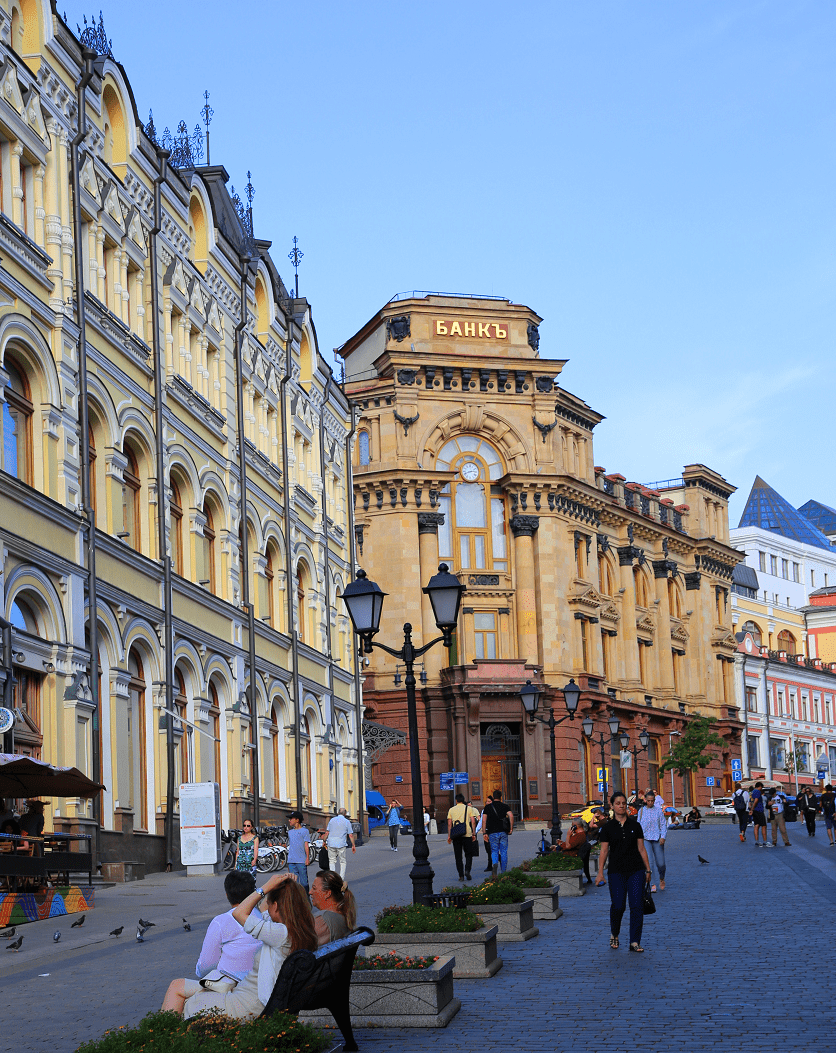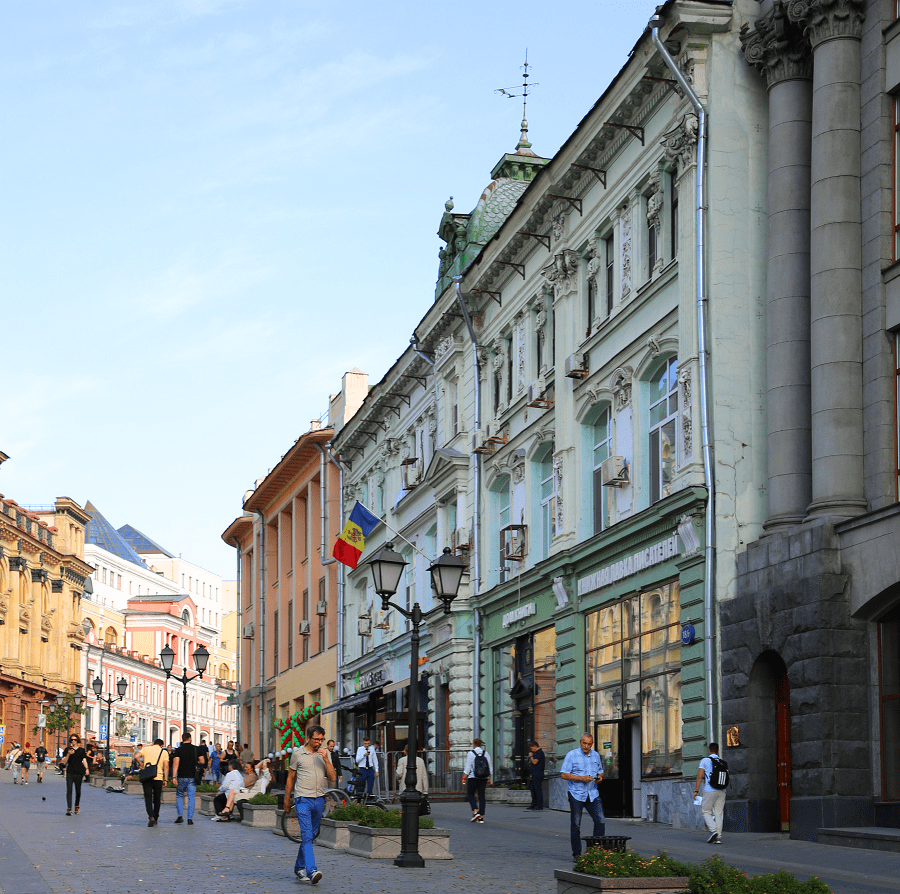Kuznetsky Most Street is a street in the Meshchansky and Tverskoy districts of the Central Administrative District of Moscow. It runs from Bolshaya Dmitrovka Street to Bolshaya Lubyanka Street. The numbering of houses is from Bolshaya Dmitrovka.
Kuznetsky Most is one of the oldest streets in Moscow, the appearance of which is associated with the construction of the Cannon Yard in this area. The name retains the name of the Kuznetsky Bridge across the Neglinnaya River. The historical traditions of the Kuznetsky Most are preserved to this day.
In the 17th-18th centuries, representatives of the noble families of the Myasoedovs, Saltykovs, Gagarins, Shcherbatovs, Dolgorukovs, Volynskys, Vorontsovs, Golitsyns and many others lived on the street. Starting from the 18th century and until the revolution of 1917, Kuznetsky Most was the main shopping street in Moscow – “a sanctuary of luxury and fashion,” famous for clothing stores, bookstores, photo studios and restaurants.
The Kuznetsky Most pass through the territory of the cultural layers “Old Kuznetskaya Sloboda,” “Kuznetsky Most,” and “Zvonarskaya Sloboda,” which are protected as objects of cultural heritage and federal significance. The street is replete with monuments of history and architecture.
Kuznetsky Most Street is located inside the Boulevard Ring of Moscow. It is a continuation of Kamergersky Lane and runs in an arcuate manner, successively crossing at almost right angles the radial from the center of Bolshaya Dmitrovka, Petrovka, Neglinnaya, Rozhdestvenka, Bolshaya Lubyanka. Kuznetsky Most Street is part of a semicircle of streets around the Kremlin.
The original name of the street Kuznetsky Most – Kuznetskaya, comes from the settlement of blacksmiths at the Cannon Yard, built at the end of the 15th century.
At the end of 1865, Kuznetsky Most became the first Moscow Street where lighting with gas lamps was tested, which later spread to the whole city, and in 1886 electric lighting came to the street. At the end of the 19th – beginning of the 20th century, many sections of the street became the property of several large homeowners: the brothers Tretyakov and Dzhamgarov, merchants Solodovnikov and Firsanov. At the same time, Kuznetsky Most began to be built up with high tenement houses, trading companies and bank buildings, and large stores.
After the October Revolution, most shops on the street were closed, and various institutions and organizations were housed in their premises. In the 1920s, numerous publishing houses and bookstores opened on Kuznetsky Most: The Great Soviet Encyclopedia, Moscow Worker, Land and Factory, International Book, etc.
Notable buildings
On the odd side
City estate of the Myasoyedovs (No. 1/8). On the corner with Bolshaya Dmitrovka is the Myasoedovs’ urban estate, the architectural appearance of which was formed in the middle of the 18th – early 19th centuries. The building of the property is a unique ensemble of a city estate from the time of mature classicism, unique in its completeness and stylistic integrity. The facade of the main house has remained practically unchanged, and the layout and interior decoration of the first half of the 19th century have been partially preserved.
Property No. 3 currently consists of two buildings along the facade. The address books of Moscow from 1916 to 1923 showed that Shanks’ store was located there.
Office building (left side). The house was built in 1901 according to the design of the architect M. A. Arsenyev. The three-story building adjoins one of the outbuildings of the Myasoyedovs estate. It is a rational, stylistically difficult-to-define building with decorations. After construction, the building was entirely occupied by various commercial and office institutions. In the 1930s, Mostorg’s utensils and hardware store was located here. Currently, the first floor of the building is occupied by the office of the Russian airline Aeroflot.
Profitable house of M. V. Sokol (right part). Architect I. P. Mashkov built the five-story tenement house in the style of the Vienna Secession in early 1904 for the landlady M. V. Sokol. The majolica mosaic in the attic depicting an eagle soaring over the mountains was made according to a sketch by the painter N. N. Sapunov.
“Berlin House” (No. 5/5) (Annenkov House). In 1776, a large house with a classical semi-rotunda was built on this site for the Governor-General of Siberia, I.V. Yakobi, to which two symmetrical three-story buildings adjoined, according to the art historian I. E. Grabar, the author of the building, was the Russian architect V. I. Bazhenov.
Despite the official status of an architectural monument, the house was destroyed during the reconstruction of Petrovka in 1946. In 2002, on the corner of Petrovka, an office and retail “Berlin House” was erected. The decision to build was made by the mayor of Moscow, Yu. M. Luzhkov, and the burgomaster of Berlin. A team of authors led by Yu. P. Grigoriev, I. K. Bartoshevich and K. D. Krebs worked on the development of the architectural design of the building.
Profitable house of I. I. Vorontsova – I. G. Evdokimov – Z. I. Shorina (Hotel Leipzig) (No. 7/6/9). The constructions of the Kuznetsky Most, located underground along the house, are an object of cultural heritage and federal significance. The building now houses numerous shops, boutiques and restaurants. The building is classified as a cultural heritage site of regional importance.
Profitable house (hotel and restaurant “Yar”) (No. 9/10). The house is classified as a valuable city-forming object. In 1826, the Frenchman Tranquil Yard (Yar) opened a hotel and a famous restaurant of French cuisine, “Yar” in this house, which A. S. Pushkin and other prominent figures of Russian culture repeatedly visited.
Passage San Galli (Moscow House of Artists) (No. 11). Since 1930, the building has been used for art exhibitions: at first, the Vsekokhudozhnik cooperative was located here, and from 1953 to the present day, the Moscow House of Artists. In 1965, the passage was radically rebuilt. In 2001, according to the surviving drawings, the building was returned to its pre-revolutionary appearance. The modern Moscow House of Artists has hosted exhibitions and fairs and has a restaurant, a gift shop, and an art salon. The building is an object of cultural heritage of regional significance.
Profitable house of P. M. and S. M. Tretyakov (Bank Lyon Credit) (No. 13/9).
Moscow International Trade Bank (No. 15/8). The architectural prototype of the house built in the Renaissance style was the building of the Bank of the Holy Spirit in Rome, the first building in the history of architecture explicitly built for banking needs. The monumental banking building is lined with Radom sandstone and decorated with zinc ornaments.
Tver Compound (No. 17). In 1974, the ensemble of the Tver Compound was included in the list of historical and cultural monuments of republican significance. However, in 1996, four ensemble buildings were demolished, and the two-story building overlooking Kuznetsky Most was “recreated” by a new complex designed by A. R. Vorontsov.
Profitable house of Prince A. G. Gagarin (Mur and Maryliz store) (No. 19). The modern four-story building was designed in two phases (1886 and 1898, architects V. A. Kossov and R. I. Klein) and includes chambers and outbuildings of the manor complex, built in the 18th – first third of the 19th centuries. In 1915, the building was redesigned according to architect V. G. Piotrovich’s project.
Profitable house of the First Russian Insurance Company (No. 21/5). An identified object of cultural heritage.
On the even side
Solodovnikov Theater (Opera by S. Zimin) (No. 2/6). The building is based on the estate of the 18th century, which belonged to the father-in-law of A. V. Suvorov, Prince I. V. Prozorovsky Jr.
The complex of profitable properties of V. S. Zasetskaya (No. 4/3). In the 18th century, the vast property, which extended deep into the quarter to Kopyovsky Lane, belonged to the princely family of Shcherbatovs.
“Kuznetsky Passage” (left side). The three-story building was built in 1893 according to the project of the architect V.P. Zagorsky to house the Kuznetsky Passage store. According to some information, N. V. Sultanov, the author of the neighboring apartment building, participated in the design of individual elements of the building. The building is classified as a valuable city-forming object.
Profitable houses of A. S. Khomyakov (No. 6).
House with a hairdresser, “Basil” (right side). The facility in the style of Austrian Art Nouveau was built in 1902-1903 according to the project of architects M. K. Geppener and I. A. Ivanov-Shitz.
Profitable house of Khomyakov (corner part). The corner building was designed in 1900 according to the project of I. A. Ivanov-Shitz. In 1931, the house was built on two floors.
Profitable house of the Moscow merchant society (No. 10/8). The building is classified as a valuable city-forming object.
Passage of K. S. Popov (Dzhamgarovs) (No. 12).
The building of the trading company of A. M. Mikhailov (No. 14).
House of the bank and trading house I. W. Juncker & Co. (No. 16). In 1876, the building was redesigned according to the project of the architect P. S. Campioni. In 1878, the property was acquired by the trading house I. W. Juncker & Co, by order of which in 1900-1908, the building was again rebuilt in the style of early Moscow Art Nouveau by the architect A. E. Erichson.
Profitable buildings of the Dzhamgarovs (No. 18/7).
Profitable house of Torletsky – Zakharyin (No. 20/6/9). The building is an object of cultural heritage of federal significance.
The complex of buildings of the Federal Security Service of the Russian Federation (No. 22-24). In 1982, on the site of the demolished houses of the firm F. Shvabe, according to the project of architects B. V. Paluy and G. V. Makarevich, the facilities of the KGB of the USSR (now the Federal Security Service of the Russian Federation) were built.
Transport
Teatralnaya and Okhotny Ryad stations are located 250 meters from the beginning of the street, and Lubyanka is 210 meters from the end of the street. In the courtyard of house No. 20/6/9, there is an above-ground vestibule of the Kuznetsky Most station (passage through the arch from Rozhdestvenka and through the opening in the building from Kuznetsky Most Street).
See more streets and squares in Moscow, monuments of Moscow, architecture of Moscow.






















